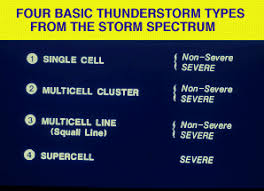Geography Notes On – Types Of Thunderstorms – For W.B.C.S. Examination.
ভূগোল নোট – বজ্রপাতের প্রকার – WBCS পরীক্ষা।
At one time, thunderstorms were classified according to where they occurred—for example, as local, frontal, or orographic (mountain-initiated) thunderstorms. Today it is more common to classify storms according to the characteristics of the storms themselves, and such characteristics depend largely on the meteorological environment in which the storms develop. The United States National Weather Service has defined a severe thunderstorm as any storm that produces a tornado, winds greater than 26 metres per second (94 km [58 miles] per hour), or hail with a diameter greater than 1.9 cm (0.75 inch).Continue Reading Geography Notes On – Types Of Thunderstorms – For W.B.C.S. Examination.
Isolated thunderstorms
Isolated thunderstorms tend to occur where there are light winds that do not change dramatically with height and where there is abundant moisture at low and middle levels of the atmosphere—that is, from near the surface of the ground up to around 10,000 metres (33,000 feet) in altitude. These storms are sometimes called air-mass or local thunderstorms. They are mostly vertical in structure, are relatively short-lived, and usually do not produce violent weather at the ground. Aircraft and radar measurements show that such storms are composed of one or more convective cells, each of which goes through a well-defined life cycle. Early in the development of a cell, the air motions are mostly upward, not as a steady, uniform stream but as one that is composed of a series of rising eddies. Cloud and precipitation particles form and grow as the cell grows. When the accumulated load of water and ice becomes excessive, a downdraft starts. The downward motion is enhanced when the cloud particles evaporate and cool the air—almost the reverse of the processes in an updraft. At maturity, the cell contains both updrafts and downdrafts in close proximity. In its later stages, the downdraft spreads throughout the cell and diminishes in intensity as precipitation falls from the cloud. Isolated thunderstorms contain one or more convective cells in different stages of evolution. Frequently, the downdrafts and associated outflows from a storm trigger new convective cells nearby, resulting in the formation of a multiple-cell thunderstorm.Solar heating is an important factor in triggering local, isolated thunderstorms. Most such storms occur in the late afternoon and early evening, when surface temperatures are highest.
Multiple-cell thunderstorms and mesoscale convective systems
Violent weather at the ground is usually produced by organized multiple-cell storms, squall lines, or a supercell. All of these tend to be associated with a mesoscale disturbance (a weather system of intermediate size, that is, 10 to 1,000 km [6 to 600 miles] in horizontal extent). Multiple-cell storms have several updrafts and downdrafts in close proximity to one another. They occur in clusters of cells in various stages of development moving together as a group. Within the cluster one cell dominates for a time before weakening, and then another cell repeats the cycle. In squall lines, thunderstorms form in an organized line and create a single, continuous gust front (the leading edge of a storm’s outflow from its downdraft).Sometimes the development of a mesoscale weather disturbance causes thunderstorms to develop over a region hundreds of kilometres in diameter. Examples of such disturbances include frontal wave cyclones (low-pressure systems that develop from a wave on a front separating warm and cool air masses) and low-pressure troughs at upper levels of the atmosphere. The resulting pattern of storms is called a mesoscale convective system (MCS). Severe multiple-cell thunderstorms and supercell storms are frequently associated with MCSs. Precipitation produced by these systems typically includes rainfall from convective clouds and from stratiform clouds (cloud layers with a large horizontal extent). Stratiform precipitation is primarily due to the remnants of older cells with a relatively low vertical velocity—that is, with limited convection occurring.
Our own publications are available at our webstore (click here).
For Guidance of WBCS (Exe.) Etc. Preliminary , Main Exam and Interview, Study Mat, Mock Test, Guided by WBCS Gr A Officers , Online and Classroom, Call 9674493673, or mail us at – mailus@wbcsmadeeasy.in
Visit our you tube channel WBCSMadeEasy™ You tube Channel
Please subscribe here to get all future updates on this post/page/category/website



 Toll Free 1800 572 9282
Toll Free 1800 572 9282  mailus@wbcsmadeeasy.in
mailus@wbcsmadeeasy.in


















































































































